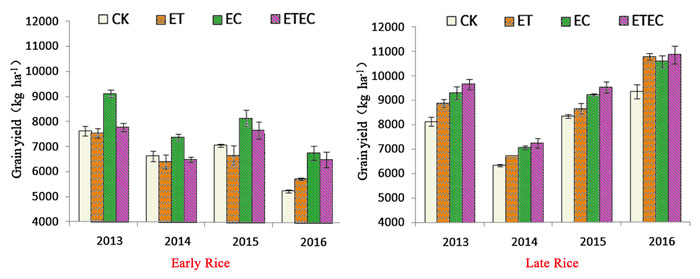| Tweet | Follow @co2science |
Paper Reviewed
Wang, B., Li, J., Wan, Y., Cai, W., Guo, C., You, S., Li, R., Qin, X., Gao, Q., Zhou, S., Liu, K., Wilkes, A. and Li, Y. 2019. Variable effects of 2°C air warming on yield formation under elevated [CO2] in a Chinese double cropping system. Agricultural and Forest Meteorology 278: 107662.
While many studies have examined the potential impacts of elevated CO2 concentrations on field crops, few have done so across multiple growing seasons. What makes the work of Wang et al. (2019) so helpful is that they did so for rice within a double rotation across four separate growing seasons in concert with a change in temperature. More specifically, over the period 2013 through 2016, the 13 Chinese scientists grew an early (cv. Liangyou 287) and late (Xiangfengyou 9) season rice cultivar in the field in open-top chambers under a full-factorial design of two CO2 concentrations (ambient and ambient plus 60 ppm) and two temperature regimes (ambient and ambient +2°C).
In describing their findings, Wang et al. report that "CO2 enrichment influenced grain yield positively and indirectly, through fertile spikelet number and aboveground biomass at maturity, both in early rice and late rice," adding that "although rice [grain] yield varied with year, [the 60 ppm rise in CO2] increased yield by 11.3-28.7%" (see Figure 1 below). Warming, on the other hand, resulted in a slight decline (-0.5%) in early season rice grain yields when averaged across all four growing seasons (compared to ambient temperature and ambient CO2 conditions), whereas it enhanced grain yields for late-season rice by around 8%. And when the two parameters were combined in the elevated temperature and elevated CO2 treatment, yield gains of approximately 8% and 16% (compared to control conditions) in the early and late season rice varieties, respectively, were observed.
Consequently, in light of the above findings, Wang et al. write that "the benefit of CO2 enrichment for yield formation can reduce or eliminate the negative effects of warming, while warming also has positive effects in both early and late rice." Hence, they conclude "we should pay attention to the probably increase of grain yield induced by warming and CO2 enrichment in the Chinese double rice system, and reconsider the direction of rice yield changes in China under future climate change."
What we consider to be most significant of the above findings is the magnitude of the positive effects of CO2 on rice yields considering that the enriched atmospheric CO2 concentration was a meager 60 ppm above ambient conditions. At the current global CO2 growth rate, such yield increases can be expected within a mere three short decades from now!

Figure 1. Grain yield of early (left panel) and late (right panel) rice under different treatments of elevated temperature and/or atmospheric CO2 across four growing seasons. CK = ambient CO2 and ambient temperature, ET = elevated temperature and ambient CO2, EC = elevated CO2 and ambient temperature, and ETEC = elevated temperature and elevated CO2. Bars indicate standard errors of three replicates. Adapted from Wang et al. (2019).




